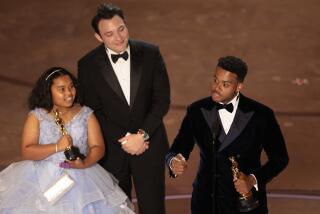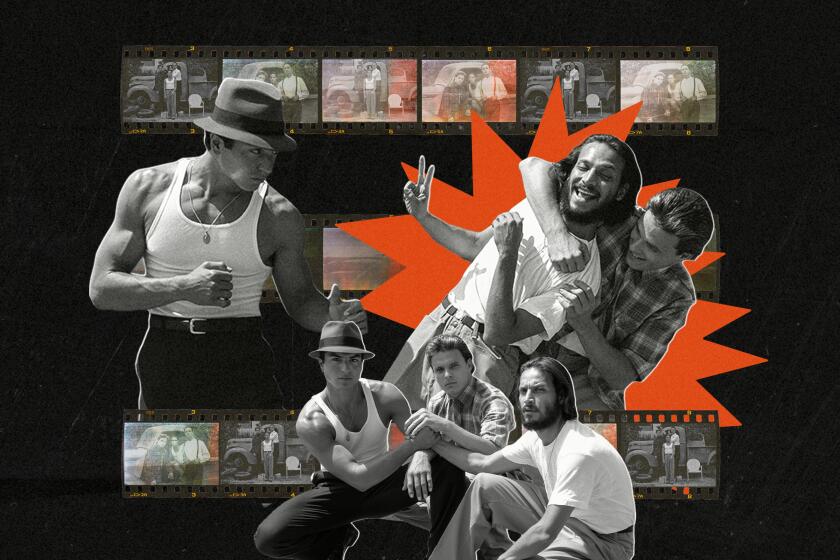Students Flip Over Film Class : Glendale: Horace Mann youths learn the art of animation well enough to win 3 cinematic awards.
Alfred Isagulyan is directing an animated film.
“Change scene!” 11-year-old Alfred commands. A flurry of hands respond, rearranging a paper lizard’s body segments beneath a Super-8 camera lens.
“Go!” the sixth-grader orders, as the lizard makes its way, frame by frame, from leaf to tree to flower.
The complex process of creating animation has suddenly become elementary. Elementary in setting only, that is. For fifth- and sixth-grade students at Glendale’s Horace Mann Elementary School, the undertaking is as painstaking as found in any Burbank studio.
After three years of teaching animation at Horace Mann, teacher Kim Labinger said she is still “the blind leading the blind.” But her students’ films tell a different story. Three of the 25 one-minute creations have captured honorable mention awards at the Los Angeles Student Film Institute’s annual festival. The nonprofit, Studio City-based institute encourages animated filmmaking in secondary and primary schools.
Labinger started her film project, held during daily language arts classes, after becoming intrigued with another teacher’s animation program.
“Kids live and breathe cartoons, TV and movies,” said Labinger, 37. “And school seems like a foreign place for many students,” she said, referring to their preference for popular culture over academics. “I thought animation could bridge that gap and teach them some skills along the way.
“This project incorporates art, music, literature and writing. Plus, they learn patience, discipline, revision skills, manual dexterity and team skills. It’s a perfect teaching tool,” said Labinger, who finances the project herself due to school budget cuts. Although she has managed to borrow and get donations of equipment, Labinger said she has spent about $350 on film and processing since the project began.
When starting the class, students create flip books to learn the rudimentary elements of animation. “We also talk about what makes a good story,” said Labinger, who works with a new group of animation students each year. “That’s a really important aspect that’s ongoing. We read lots of books, short stories, plays and poetry--anything to enrich the process of reading and writing.”
After choosing one story, students make cutouts of characters and begin the animation process, splitting into eight groups, with each group animating one scene.
“If we film one book together first, the kids get a realistic idea about which of their own stories will work on film,” Labinger said. Each group then creates its own story lines and storyboards, later animating, editing and dubbing in music and sound effects for their creations--a one-month process from start to finish.
On a recent afternoon, three students labored under two 75-watt gooseneck lamps and a Yashica Electro-8 camera. Diane Jung, 12, snapped pictures using a cable-release cord, Alfred continued in his role as director, and Marivic Guevara, 11, shifted the cutouts around.
“This is just a question, but why is the tree moving?” asked Labinger, stopping by to supervise. She explained that previously, trees and plants had moved in the scene while the lizard remained motionless, only its jointed legs moving back and forth. It’s a trick the students learned from watching “The Flintstones” cartoons in which Fred and Wilma appear to run as the same background scene speeds past over and over again.
But now the lizard was climbing down a tree. “We don’t want to have walking trees and bushes,” said Labinger, taping down the tree. “You have to keep track of where each piece is between camera shots.”
“This is hard right now,” Alfred said, “but when you see the finished movie, it’s great. It’s neat to see the mistakes you make.”
“It takes a couple of weeks just to make a short scene,” added Diane, adjusting a lamp. “And it took two or three years to make ‘Beauty and the Beast.’ When we see cartoons on TV now, we look at them differently. They’re very, very smooth because the figures are moved just a little bit. That’s hard to do.”
Other students sat at desks, drawing stories they would soon animate. “Titanic II” purports to show the “real” reason why the ocean liner sank--because a jet plane crashed into it. “Wipe Out,” explained Edgar Gomar, 12, is about a “dude who’s surfing in the ocean. The wave gets too big for him, he hits a tree, coconuts fall on him and he dies.”
“Breaking Out of Jail,” Alfred explained, “is about a guy named Ed who escapes from jail. He goes to rob this house, but this old man there looks at his TV and sees the robber’s picture on ‘America’s Most Wanted.’ So he calls and gets a $1,000 reward.”
Last year’s films range from shaky, sometimes blurry creations to amazingly smooth, animated action. The films’ ending credits are sometimes longer and more creative than the actual feature. In “The Winning Shot,” basketball players shoot baskets from a viewing angle only Salvador Dali could manage. The film’s credits feature basketballs that interact with moving letters in a whimsical fashion.
Horace Mann students also filmed a 15-minute documentary of their work last year, shown along with their nine animated films during a premiere night. Students also traveled to Yale Laboratory, a commercial film-processing plant in Hollywood, where they saw firsthand how their film was developed.
“If they don’t go, the final film seems like magic--there’s a missing link between what was in the camera and what came back to them on a reel,” said Labinger, who tells students to view their classroom as a studio when animation is being created.
Horace Mann is one of about 30 Los Angeles County public and private schools that teach animation, said Brenda Norman, executive director of the Los Angeles Student Film Institute, formed in 1978. The institute’s annual film festival receives about 1,200 entries from the primary and secondary schools. Horace Mann is the only San Fernando Valley school that participates, Norman said.
Most schools hold their own year-end animation screenings, where finalists are selected for the institute’s annual festival, held at the Directors Guild in Hollywood. Some festival winners have gone on to become Disney animators--including John Ramirez, who attended Rowland Heights High School.
“I had always dreamed of working at Disney’s Burbank Studios. Thanks to the animation program at Rowland, now I do,” said Ramirez, 24, who worked as an assistant animator on “Beauty and the Beast” and is now helping to draw the character of Jafar for Disney’s upcoming animated feature, “Aladdin.”
“I always drew as a kid,” Ramirez said. “The program came at the perfect time in my life; I craved the kind of challenge it gave me.”
“I’m awed by these students and the fresh eye they have; it’s as though they’re doing the first animated film in the history of the world,” said festival judge Lee Mishkin, who heads a Burbank animation firm. “Occasionally a real prodigy comes along. It’s exciting to be in on the beginning of their careers. It’s like we’re organizing a school band and Mozart shows up to try out.”
Back at her classroom, Labinger held up a storyboard from “Wipe Out,” showing how students created an extra-long picture that could be moved in front of the camera. “See how they slit the paper so the wave could travel through it from one end of the paper to the other?” she asked. “So now it will look as if the wave goes on for a long time.
“They’ve learned this from watching last year’s surfing story where the wave didn’t have much room to move. That’s being creative--exploring, but not knowing if what you create will work. So you experiment and try it out.”
Labinger’s words reminded Norman of one memorable film, “The Red Bicycle,” entered in the festival several years ago.
“It was a short film about the state of education today,” Norman said. “It’s about a teacher who is teaching her students to ride a bicycle by reading from a book. They all pass the written test, but fail when it comes time to ride their bikes.
“But one kid already knows how to ride from pure experience, so he hops on his bike and the rest cheer. And that’s exactly what animating stories is about--rolling up your sleeves and doing it.”
More to Read
Only good movies
Get the Indie Focus newsletter, Mark Olsen's weekly guide to the world of cinema.
You may occasionally receive promotional content from the Los Angeles Times.






